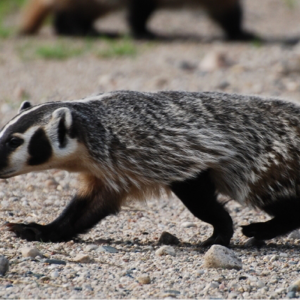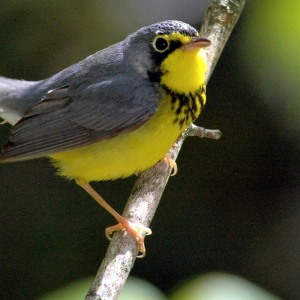Rat kangourou d’Ord
Vital Signs
Common name: Ord’s Kangaroo Rat
Latin name: Dipodomys ordii
Status under SARA: Endangered, 2006 COSEWIC assessment: Endangered
Range: The isolated Canadian population (a separate and slightly different US population exists) of Dipodomys ordii occupies a small area in southwestern Saskatchewan and southeastern Alberta. Kangaroo rats occupy sparsely vegetated, sandy habitat as a part of the mixed grassland eco-region of the prairie eco-zone in the vicinities of the Great Sand Hills, Saskatchewan and the Middle Sand Hills, Alberta.
Life Span: Most Ord’s Kangaroo Rats in Canada survive less than one year.
Size: Weight between 68 g and 71 g. Total length (including tail) between 260 mm and 263 mm.
Population Estimate: The Canadian population drops to 1,000 individuals or fewer during its seasonal low-point in early spring.
The Facts
- The kangaroo rat is not a direct relative of the common rat. Unlike domestic rats, kangaroo rats don’t spread disease or have a negative effect on crops. In fact, “K-Rats” need to live in open arid landscapes that are so marginal for farming they could scarcely cause any trouble to humans.
- The nocturnal rodent’s hearing is tuned to low frequency sounds, which helps it detect the beat of owl wings. Its tufted tail, which accounts for more than half its length, helps it jump – yes, like a kangaroo – from place to place to avoid prey. They can leap as far as six feet (1.8 m) and as high as 1.3 feet (40 cm).
- Breeding whenever favourable conditions arise, an average three-rat litter arrives after one month of gestation. Lactating females can even conceive before their previous litter is weaned, resulting in four-litter years. Less than two months after birth, maturing rats are ready to produce a family of their own.
- Most kangaroo rats travel less than 500 m in their lifetime and Canadian populations occupy as little as 53 km2 of total land area. The nearest population in the US is 270 km away, so it is extremely unlikely the populations will ever merge.
- Canadian Ord’s Kangaroo Rats are the only ones of their kind to “hibernate” in winter when the ground is snow covered or when temperatures are too severe. Sleep can last 17 hours and happens about 70 times a winter. High death rates occur due to starvation and freezing. Kangaroo rats have, however, been spotted outside at –19 degrees Celsius during snow-free periods.
- Kangaroo rats help maintain balance in their dune community. They remove seeds and grasses, which disturbs the soil. Additionally, their seed collection and caching behaviour leads to a large number of abandoned seed caches for germination or for other granivores to exploit.
The Story
For 52 years, Alberta’s Rat Patrol has been using shotguns, shovels and poison to eradicate rats. Patrollers roam the Saskatchewan border to protect the province from these pesky destroyers of crops and harbingers of disease which are often thought of as the epitome of urban neglect, helping Alberta remain the only rat-free region in North America. One species of rat has escaped the Rat Patrol’s radar – Ord’s Kangaroo Rat. This is surprising because they live in one of the most heavily inspected and guarded areas in the province: Canadian Forces Base Suffield. More than half of the population’s range is amongst the dunes and low scrub in the eastern buffer zone of the military base.
Kangaroo rats are on COSEWIC’s endangered species list and may soon meet the same fate provincially as their distant rodent brethren. Kangaroo rats live primarily in actively eroding sand dunes and sand flats. These areas are sensitive to both climatic change and human land-uses – areas that may be gone within 10 years.
Combine shrinking dunes and a population susceptible to winter kill and you have the makings of a foreboding future. Add EnCana Corporation’s plans to drill 1,275 new gas wells near rat habitat – doubling its current fleet – and you have a recipe for extirpation.
Although 458 km2 of the eastern buffer of Canadian Forces Base Suffield was designated a National Wildlife Area (NWA) in 2003, EnCana Corporation is still planning to drill within that same protected area. Learn what you can do to stop this.
EnCana’s application proposes buffer zones around rat habitat and promises not to build more roads, but increased traffic and the construction of new pipelines to connect the wells to existing and new infrastructure may cause problems.
“Roads create unnatural open-area habitat that rats are attracted to,” says Andy Teucher, a researcher studying the effects of unnatural versus natural habitats for the rats.
These “linear dunes” create habitat but they also act as highly efficient corridors for predators like Coyotes, badgers and foxes. Non-native plants along the artificial dunes lead to less optimal forage, which means survival rates for kangaroo rats that live along roadways are not sustainable. “Rats in natural sites have a higher body condition; they seem to be fitter,” says Teucher.
Losing kangaroo rats would eliminate a critical link in the prairie ecosystem. “We just don’t know how many species we can lose before the ecosystem collapses,” explains Teucher.
What You Can Do
Ord’s Kangaroo Rats are a key focal species for the conservation of prairie sand dunes. Many other species at risk depend on these declining habitats.
- Visit the Royal Alberta Museum in Edmonton to learn more about prairie ecosystems.
- Appreciate the prairie ecosystem in person. You cannot visit Suffield NWA, but Saskatchewan’s Great Sand Hills are open to the public.
Resources:
Species at Risk Registry (SARA)
COSEWIC Assessment
Written by Raymond Schmidt


